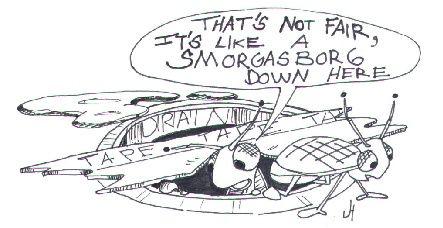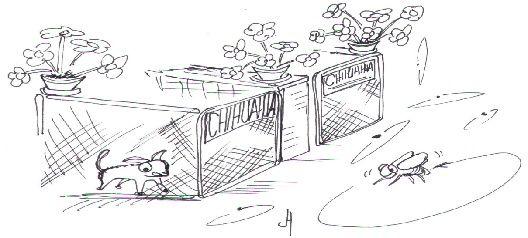Natural Solutions to Things That Bug You (56 page)
Read Natural Solutions to Things That Bug You Online
Authors: Myles Bader

KEEPS THEIR BREATH FRESH TOO
Trying crushing some fresh mint and placing it into 1-2 sachets, then hang the sachets around the home or on the patio to repel flies.
HERBAL REMEDIES
Use bay leaves, pennyroyal, eucalyptus or cloves in a muslin bag and hang them around the house. Pound them to release the essence before placing them into a bag.
If you place some sweet basil in a small container in the kitchen or near a pets food dish it will repel flies. You can also plant sweet basil or rue around the doorways or place a cotton ball with a few drops of eucalyptus oil on it in a shallow container in the kitchen.
FLYPAPER 101
To make your own flypaper, just mix together:
¼ Cup Karo® syrup
1 Tablespoon granulated sugar
1 Tablespoon of brown sugar
Cut strips of brown craft paper and soak it in the mixture, then allow it to dry overnight. Place a string in a small hole on top and hang wherever you have a problem.
MAKE A FLY OMELET
Beat 1 large egg yolk with 1 tablespoon of molasses and add 2 pinches of finely ground black pepper, then place the mixture in a shallow paper plate.
DUST OFF THE DOO, DOO
If you don’t want to pick up after the pet, then dust the pile with garden grade diatomaceous earth (DE). DE can be fed to your pet and the flies will stay away from their feces.
For cats feed ½ teaspoon every week, dogs should get ½ tablespoon each week and horses can get ¼ cup added to each meal. The flies won’t even go near the horse manure.
SEND YOUR FLIES TO PEACEFUL VALLEY
This will be a permanent vacation for the flies. The trap is called the Peaceful Valley Fly Trap and is sold through most farm supply house. It will accommodate up to 25,000 flies. The trap used yeast and ammonium carbonate to attract the flies.
WHAT’S GOING ON DOWN THERE?
If you notice a number of very small flies and don’t know where they are coming from it is probably from your kitchen drain. They are called drain flies and live in the drain on rotted foods. To trap them just place some duct tape over the drain at night, sticky side down. Pour vinegar down the drain and rinse out after a few minutes.

CARPET THE AREA
Cabbage root flies tend to lay their eggs close to young cabbage plants. To stop them from laying their eggs too close, just place a small circle of carpet with a slit so that it will wrap around the small plant and protect the base.
KEEP YOUR CAN CLEAN
Garbage cans and trash compactors can produce 1,000 or more fly eggs per week unless they are sealed tight. The problem can be solved with lavender oil. If you have a fly problem place a few drops of lavender oil on a piece of cotton and place it in the garbage can or an empty trash compactor bag before you start adding garbage.
You can also place a mint sprig in each can every week. Better yet just sprinkle the bottom of the can with insecticidal soap.
ESSENTIAL OILS TO THE RESCUE
There are a number of essential oils that will repel flies very effectively. The most effective are oil of peppermint and oil of cloves. If you place oil of lavender on a sponge and leave it in a room it will repel flies.
CLEAN UP AFTER YOUR PET
One of the preferred spots for flies to multiply on is your pet fecal material. It would be best to clean up after your pet daily to reduce the fly population around your home and garden area.
WHEN IS A FLY NOT A FLY?
When it is a whitefly, which is really a member of the insect family and not a “real” fly. They have four wings while flies only have two wings. They will suck the juices from plants and like to hang around greenhouses as their preferred residence. They lay their eggs on the underneath sides of leaves. They can be controlled in a greenhouse if you release the parasite
Encarsia formosa.
Also, ladybugs and lacewings enjoy munching on these bugs. A soap spray with a small amount of rubbing alcohol and coconut oil will dissolve the waxy coating on their larvae and kills them.
LEMON GRASS VERY PRETTY
If you have a problem, keeping flies away from your plants, just rub the leaves of the lemon grass plant on their leaves. By just rubbing the leaves on your plants it will provide the plant fly protection.
CAMPHOR TREE DOES THE JOB
If you plant a camphor tree near your kitchen it has the ability to repel flies. Chinaberry trees will also do the job.
FIGHT FLIES WITH FLIES
Wherever manure is you will find flies, especially around chicken ranches and stables. There a number of companies that sell fly parasites that can be released in these areas to control the fly population. The parasites deposit their eggs on the fly larvae or pupae in the manure and prevent them from becoming flies.
FLY MINTS
 If you crush up some fresh mint and rub it on an animal, especially a horse it will keep the flies away for some time. The flies will not even land on them.
If you crush up some fresh mint and rub it on an animal, especially a horse it will keep the flies away for some time. The flies will not even land on them.
LITTLE GAME HUNTER
There are a number of commercial flytraps sold on the market. If you do purchase one be sure that it is not placed in direct sunlight, since filtered sunlight works best. Ripened fruit works best in the trap, but if that is not available a combination of cornmeal mixed with molasses works almost as well.
ZAPPERS DON’T WORK WELL WITH FLIES
Flies are unable to see ultraviolet light during the day so placing a zapper outside in daylight will not work well and at night flies are inactive. All you end up doing is killing the beneficial insects.
SOUTH OF THE BORDER
If you enter a dog kennel or stables and wonder what the plants are hanging from the doorways, it is probably Mexican marigolds. This plant has been used as a fly deterrent for hundreds of years and is still in use today.

GET A GIANT FLYSWATTER AND AIM FOR THEIR BACKSIDE
One of the best methods is still the good old flyswatter. For every fly that you kill, hundreds will not be born. A mesh flyswatter with a metal handle works the best. Be sure and wash the flyswatter in hot soapy water because of the bacteria and disease that they could harbor.
CHASE THEM WITH HAIRSPRAY
Better be sneaky and have a good aim, however, this works really well and is a bit challenging.
FAN THE FLIES
Flies do not like fast moving currents of air and will avoid them at all costs. If you have a fan over ever doorway that opens into the house, you will never have any flies in your home.
SPRINKLING MANURE
If you have areas with manure in piles it would be wise to sprinkle diatomaceous earth (DE) on the manure to reduce the fly population.
CITRUS REPELLANT
Scratch the skin of an orange and leave it out; the citrus acts as a repellent and will keep flies out of the room.
WON’T WORK LIKE MISTLETOE
If you hang a small sprig of ragwort over a doorway it will repel houseflies in the summer. Be sure that you are using the “real” thing.
Ragwort has the botanical name of
Senecio jacobeae
and is part of the family
Compositae
.
Look for feathered leaves and clusters of bight orange flowers that look like daisies. Ragwort has a somewhat pungent smell, best to hang it just outside the door.
GREEN FLIES
 Green flies, or green bottle flies, are shiny and metallic green in color with large eyes that are compound and tinted red. Like other blow and bottle flies, these flies are commonly found on farms. Adults feed on pollen, serving as key pollinators for plants that mimic the smell of carrion.
Green flies, or green bottle flies, are shiny and metallic green in color with large eyes that are compound and tinted red. Like other blow and bottle flies, these flies are commonly found on farms. Adults feed on pollen, serving as key pollinators for plants that mimic the smell of carrion.
Although painful, green flies are not known to transfer diseases through biting. Rather, the transfer of pathogens occurs when they land on food or food preparation surfaces after coming into contact with carrion or feces.
Female flies choose dead and wounded animals, as well as feces, within which to lay their eggs.
Green bottle flies are particularly fond of dog feces and large populations may be found in dog parks and dog runs as a result. After hatching, yellow-gray larvae feed for two to 10 days, amassing enough body weight to last through their upcoming pupa stage. The scientific community has taken special interest in the larvae of these flies for their potential to treat necrotic flesh wounds in sanitized, controlled conditions.

ONION FLY
